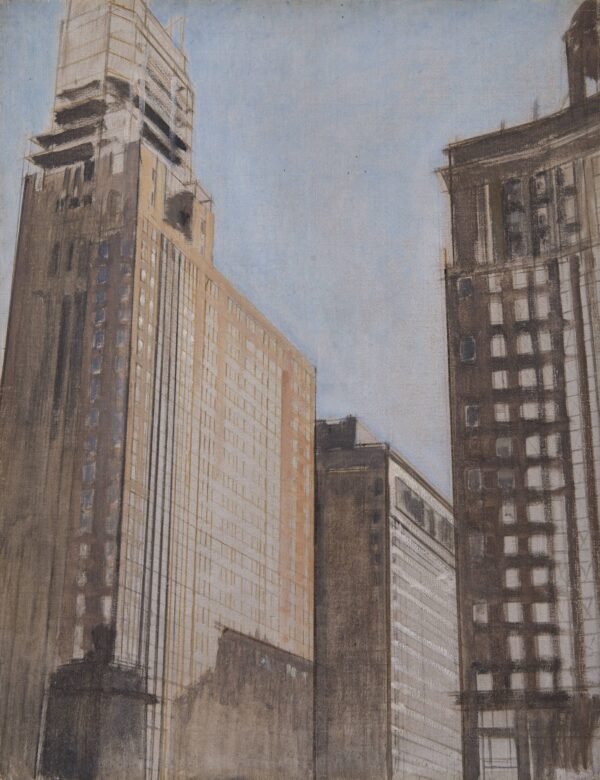Study of Chicago – Michigan Avenue Study from Rush Street, 1928
Oil on canvas, H. 0.66 m; W. 0.51 m
Provenance: Private collection
During his visits to the United States from 1926, Bernard Boutet de Monvel, renowned for his portraits of American high society, also became a painter of urban landscapes, in which he sought to capture the modernity of cities under construction. His stunning views of steel mills and skyscrapers, which are a significant part of his work, make the artist a major figure in the Precisionist movement.
The son of painter and illustrator Louis-Maurice Boutet de Monvel (1850-1913), Bernard Boutet de Monvel (1881-1949) planned a career in painting during the final years of the 19th century. A pupil of Luc-Olivier Merson (1846-1920), he took up etching at an early age, quickly becoming a recognised master of the medium, although he never neglected painting. From 1909 onwards, he worked in an Art Deco style, making geometric portraits with a limited palette. At the same time, he illustrated fashion magazines, notably the Gazette du Bon Ton, Vogue, and Harper’s Bazar.
Boutet de Monvel also made a name for himself as a painter of sportsmen and dandies. A very handsome man, he was considered one of the most elegant of his time. On his first trip to New York in 1926 for a retrospective exhibition organised by Anderson Galleries, the man already described by the press as “the most handsome man in Europe” became the leading portraitist of Café Society: Getty, Vanderbilt, Astor, and du Pont were his most regular models.
Commission for a bank in Chicago
In December 1927, during a retrospective show of his painting and sculpture organized by decorator Rue Winterbotham Carpenter (1879-1931) at the Chicago Arts Club, Bernard Boutet de Monvel, was commissioned to create a large composition for the reception hall of a Chicago bank.[1]
Bernard Boutet de Monvel saw this commission as an opportunity to demonstrate his talent as a painter-decorator on the other side of the Atlantic, and in January 1928 he started making preparatory studies and models. These artworks mark the artist’s initial exploration of the modernity of the United States.
The picture, representing all the glory of American industry, shows Abundance Feeding the Children of America[2] in front of a blast furnace connected by a train to a building under construction. Despite the complexity of the composition, the artist worked with the rhythm of the angles with obvious ease – the regularly repeated rhythm of the building façades treated in solid colours, and the dynamic, powerful pattern of the gas pipes.
Developing a Composition with Photographs
After visiting a steelworks to prepare the left side of his panel, Bernard Boutet de Monvel walked along the Chicago River to photograph the buildings under construction for the right side. He chose the buildings on Michigan Avenue as seen from Rush Street: on the left, still unfinished, the Michigan Building (1927-1928)[3] at 333 Michigan Avenue, followed by 319, and on the right, the London Guarantee Building (1923) at 360. Between these three buildings is a void.
Constrained by the focal range of his camera, Boutet de Monvel used not one, but two, adjacent shots to set up his composition (Fig. 3 and 4). After transferring the photographs’ grid to the canvas, he eliminated the entire lower section of these images showing Michigan Avenue Bridge,[4] but only an urn with flame finial on top of one of the four masonry lanterns at the ends of the bridge is visible in the painting. In this way, as is frequently the case, the artist has based the structure of his image on clear photographic objectivity. Once the preparatory drawing had been created with a ruler and compass, Boutet de Monvel quickly sketched out the mass of buildings using oil paints that were heavily diluted with gasoline, called “jus”, so as to indicate only the tones and values: sienna, natural and burnt umber, cobalt blue, white highlights, etc. Then, while entire sections of the canvas were still in reserve, the work was abandoned.
Clearly, the excessive space left for the sky meant that the powerful diagonal governing the composition could not be properly integrated with the rest of the panel. Boutet de Monvel therefore created a second sketch (Fig. 5),[5] which would be used for the final composition. This time it was based on photographs taken the previous year in New York, showing a group of buildings in front of which cranes and hoists are lifting steel beams. In this ‘city of windows’, Boutet de Monvel had discovered a new Metropolis, a futuristic city in the throes of transformation.
This first sketch, which already highlights the repetition of windows as geometric shapes, remains the only view of Chicago made by the artist that has survived. It was, with the second, the originator of all the New York landscapes produced by the painter between 1928 and 1932. These are vertiginous compositions, all made from photographs, so characteristic of Precisionism, the founding movement of American modernism that oscillated between hyperrealism and cubism.
Stéphane-Jacques Addade[6]
[1] The A. G. Becker & Co, investment bank located on LaSalle Street, which had just been completely renovated by Samuel A. Marx (1885-1964).
[2] Oil on canvas, H. 2 m; W. 2,50 m, unknown whereabouts, see S.-J. Addade, Bernard Boutet de Monvel, 2001, p. 204-207 and 2016, p. 223-230.
[3] Famous Art Deco skyscraper built by Holabird & Roche in 1927-1928.
[4] In 2010, this bridge was renamed DuSable Bridge.
[5] View of New York, 1928, oil on canvas, H. 0,76 m; W. 0,62 m, Sale Christie’s London, 4 March 2022, lot 433, whereabouts unknown.
[6] Stéphane-Jacques Addade, recognized expert of Bernard Boutet de Monvel, owns the artist’s archives and published two richly documented monographs in 2001 and 2016. He is also Vice-President of the European Chamber of Art Experts.
